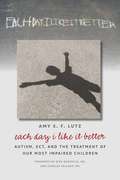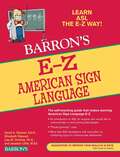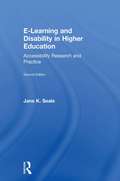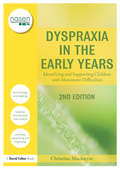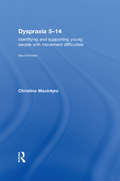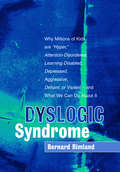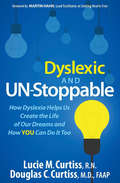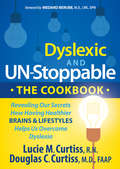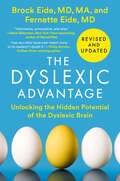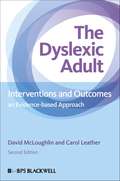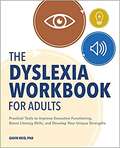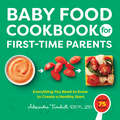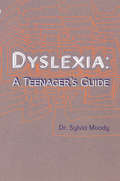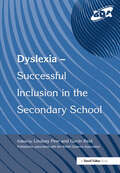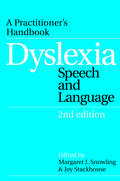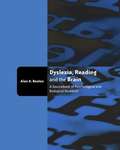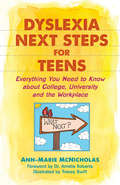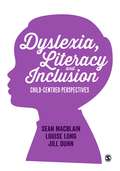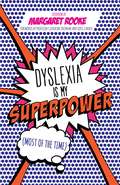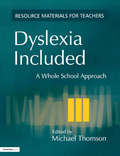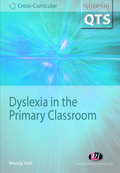- Table View
- List View
Eagles Don't Eat Worms
by Linda Kudlik Jack WeylandJeff steals a guide dog to earn a reward. He is caught, and for two months he must live as a blind person. He learns a lot about himself and others around him In addition the police officer falls in love with the blind woman. This is Morman fiction.
Each Day I Like It Better: Autism, ECT, and the Treatment of Our Most Impaired Children
by Amy LutzIn the fall of 2009, Amy Lutz and her husband, Andy, struggled with one of the worst decisions parents could possibly face: whether they could safely keep their autistic ten-year-old son, Jonah, at home any longer. Multiple medication trials, a long procession of behavior modification strategies, and even an almost year-long hospitalization had all failed to control his violent rages. Desperate to stop the attacks that endangered family members, caregivers, and even Jonah himself, Amy and Andy decided to try the controversial procedure of electroconvulsive therapy or ECT. Over the last three years, Jonah has received 136 treatments. His aggression has greatly diminished, and for the first time Jonah, now fourteen, is moving to a less restricted school. Each Day I Like It Better recounts the journeys of Jonah and seven other children and their families (interviewed by the author) in their quests for appropriate educational placements and therapeutic interventions. The author describes their varied, but mostly successful, experiences with ECT. A survey of research on pediatric ECT is incorporated into the narrative, and a foreword by child psychiatrist Dirk Dhossche and ECT researcher and practitioner Charles Kellner explains how ECT works, the side effects patients may experience, and its current use in the treatment of autism, catatonia, and violent behavior in children.
Each Day I Like It Better: Autism, ECT, and the Treatment of Our Most Impaired Children
by Amy S. LutzIn the fall of 2009, Amy Lutz and her husband, Andy, struggled with one of the worst decisions parents could possibly face: whether they could safely keep their autistic ten-year-old son, Jonah, at home any longer. Multiple medication trials, a long procession of behavior modification strategies, and even an almost year-long hospitalization had all failed to control his violent rages. Desperate to stop the attacks that endangered family members, caregivers, and even Jonah himself, Amy and Andy decided to try the controversial procedure of electroconvulsive therapy or ECT. Over the last three years, Jonah has received 136 treatments. His aggression has greatly diminished, and for the first time Jonah, now fourteen, is moving to a less restricted school. Each Day I Like It Better recounts the journeys of Jonah and seven other children and their families (interviewed by the author) in their quests for appropriate educational placements and therapeutic interventions. The author describes their varied, but mostly successful, experiences with ECT. A survey of research on pediatric ECT is incorporated into the narrative, and a foreword by child psychiatrist Dirk Dhossche and ECT researcher and practitioner Charles Kellner explains how ECT works, the side effects patients may experience, and its current use in the treatment of autism, catatonia, and violent behavior in children.
E-Z American Sign Language, 3rd Edition (Barron's E-Z Series)
by David Stewart Elizabeth Stewart Lisa DimlingA Simon & Schuster eBook. Simon & Schuster has a great book for every reader.
E-Learning and Disability in Higher Education: Accessibility Research and Practice
by Jane K. SealeMost people working within the higher education sector understand the importance of making e-learning accessible to students with disabilities, yet it is not always clear exactly how this should be accomplished. E-Learning and Disability in Higher Education evaluates current accessibility practice and critiques the extent to which 'best' practices can be confidently identified and disseminated. This second edition has been fully updated and includes a focus on research that seeks to give 'voice' to disabled students in a way that provides an indispensible insight into their relationship with technologies and the institutions in which they study. Examining the social, educational, and political background behind making online learning accessible in higher and further education, E-Learning and Disability in Higher Education considers the roles and perspectives of the key stake-holders involved in e-learning: lecturers, professors, instructional designers, learning technologists, student support services, staff developers, and senior managers and administrators.
e-Accessibility Policy Handbook for Persons with Disabilities
by Nirmita NarasimhanBased on the ITU-G3ict e-Accessibility Policy Toolkit for Persons with Diabilities
Dyspraxia in the Early Years: Identifying and Supporting Children with Movement Difficulties (nasen spotlight)
by Christine MacintyreToday there are more children than ever before in need of a variety of additional support needs, and many of these children have poor movement as a key contributory factor. Even in children with no specific ‘label’, movement is being found to be linked to learning, and educational professionals need to understand what is amiss and how to support children who do not meet their motor milestones at the correct time. The brand new topic areas featured in this comprehensive and practical new edition include: a discussion of terminology and labelling (in light of current inclusion guidelines) a range of age specific activities a section on the neurology of dyspraxia, showing the motor pathways that are energised and define motor competence a greater emphasis on balance, coordination and control examples from children of how movement is dependent on planning, sequencing and organising more practical activities that can form the basis of a programme to support the children. Practical strategies are provided throughout this authoritative book, so that teachers and other professionals can identify and understand movement difficulties, are empowered to support the children, and work effectively with the parents.
Dyspraxia 5-14: Identifying and Supporting Young People with Movement Difficulties (nasen spotlight)
by Christine MacintyreDyspraxia is increasingly common in young children. This fully revised and updated edition of Christine Macintyre’s invaluable companion explains the difficulties faced by children with dyspraxia in growing up and offers suggestions as to how these might be alleviated. In this book the children themselves, along with their parents and teachers, talk about how the difficulties change as the transition is made from primary to secondary school. Children with dyspraxia are frequently beset by frustrations as a result of their differences, can be misunderstood both at home and at school, and are very often bullied. This practical guide considers: the issue of giving children labels strategies to reduce stress the value of movement programmes raising self-esteem the transition to secondary school particular challenges faced during Puberty/adolescence handwriting as an indicator of dyspraxia. Including practical activities with additional material for secondary pupils this book shows children how to articulate their differences using individualised explanations, and then go on to succeed having recognised where their talents lie. Dyspraxia 5-14 is essential reading for teachers, parents, SENCos, teaching assistants and trainee teachers who want to improve their understanding of dyspraxia and its implications for children in Key stages 1-3.
Dyslogic Syndrome: Why Millions of Kids are "Hyper," Attention-Disordered, Learning Disabled, Depressed, Aggressive, Defiant, or Violent - and What We Can Do About It
by Bernard RimlandDyslogical children are commonly labelled as having one or more of a mix of conditions that include Attention Deficit/Hyperactivity Disorder, Conduct Disorder, Bipolar Disorder and Oppositional Defiant Disorder. The number of children who could be described as dyslogical continues to rise sharply, and society has a tendency to lay the blame for this trend on poor parenting or bad schooling. In this ground-breaking book, Bernard Rimland argues that such `conventional wisdom' is not just mistaken but dangerous. Drawing on the latest research, Rimland outlines the impact of biological factors on today's children and exposes the influences of toxins and dietary deficiencies. Dyslogic Syndrome is full of valuable advice on the safe, effective treatments that are available to children, and offers positive strategies for helping parents and professionals to do the best for their dyslogical child.
Dyslexic and Un-Stoppable: How Dyslexia Helps Us Create the Life of Our Dreams and How You Can Do It Too
by Lucie M. Curtiss Douglas C. CurtissDoes your child have difficulty with reading? Is your child's teacher complaining about behavior or attention issues? Is writing a chore for your child? Could your child be dyslexic? You are in luck. "Dyslexic AND UN-Stoppable" is not just another book about dyslexia. It is uniquely designed for both the dyslexic and non-dyslexic reader. "Dyslexic AND UN-Stoppable" shows you how Lucie Curtiss, discovered her own dyslexia at age 25, developed tools and strategies to become a successful entrepreneur. She honed these tools as she helped her dyslexic son excel at school. She then enrolled her husband, Dr. Douglas Curtiss, a Yale-trained pediatrician, to contribute to this book. Together they show you how to implement these strategies in your life so that your dyslexic child can be UN-Stoppable. Youll find practical insights, real-life success stories, and online video tutorials to help your dyslexic child with reading, writing, spelling, math, and much more. And if you are dyslexic yourself, "Dyslexic and UN-Stoppable" will Inspire and Empower you to live the life of your dreams by: - Revealing the True Gifts dyslexia offers - Describing two real-life Success Stories from a mother and a son with dyslexia - Visually teaching you Tools and Strategies you can use every day - Helping you blast through the limitations of dyslexia by Discovering Your Niche - Showing you how to Navigate the School System step by step - Reinstilling your natural Love of Learning Another word for dyslexia is smart. So use these powerful strategies, discover your unique talents, and become UN-Stoppable!,
Dyslexic and Un-Stoppable: Revealing Our Secrets How Having Healthier Brains & Lifestyles Helps Us Overcome Dyslexia
by Lucie M. Curtiss Douglas C. Curtiss Medard BerubeDyslexic and Un-Stoppable The Cookbook: Revealing Our Secrets How Having Healthier Brains and Lifestyles Helps Us Overcome Dyslexia, shares nutritional facts and healthier recipes Lucie and Dr. Doug Curtiss have incorporated in their daily routine. Dyslexic and Un-Stoppable The Cookbook complements Dyslexic AND UN-Stoppable: How Dyslexia Helps Us Create the Life of Our Dreams and How YOU Can Do It Too!, by identifying healthy, beneficial ingredients to improve the odds of overcoming dyslexia. Lucie M. Curtiss, RN, and Dr. Douglas C. Curtiss, FAAP, are the cofounders of Dyslexic AND UN-Stoppable, LLC. Their mission is to empower dyslexic children to become UN-Stoppable and overcome dyslexia by rediscovering their inner power. They are here to remind dyslexics that they are SMART!
The Dyslexic Advantage (Revised and Updated): Unlocking the Hidden Potential of the Dyslexic Brain
by Brock L. Eide Fernette F. EideAn updated edition of Drs. Brock and Fernette Eide's popular dyslexia book with a wealth of new material and improved dyslexic-friendly font. What if we viewed dyslexia as a learning and processing style rather than as a learning disorder? Drs. Brock and Fernette Eide use their impressive backgrounds in neurology and education to debunk the standard deficit-based approach to dyslexia. People typically define &“dyslexia&” as a reading and spelling disorder. But through published research studies, clinical observations, and interviews with dyslexic individuals, the Eides prove that these challenges are not dyslexia&’s main features but are instead trade-offs resulting from an entirely different pattern of brain organization and information processing that has powerful advantages. For example, dyslexic adults routinely outperform their non-dyslexic peers in studies on three-dimensional spatial reasoning and divergent creativity—one of the reasons why so many dyslexics are successful engineers. Approximately 20 percent of the U.S. population has dyslexia, and The Dyslexic Advantage shows how each one is predisposed to powerful skills called MIND strengths (Material, Interconnected, Narrative, and Dynamic Reasoning), leading them to possess incredible pattern detection, divergent thinking, episodic memory, problem solving, and prediction abilities. The revised and updated edition of The Dyslexic Advantage includes eighteen rich new profiles of remarkable individuals with dyslexia—such as several world-renowned scientists, a Pulitzer Prize–winning poet, a world-record-setting memory specialist, three MacArthur &“Genius&” Award winners, the technical advisor for the Jurassic Park movies, and many more. Meanwhile, the enormous advances in dyslexia research over the last ten years provide valuable new insights for educators, employers, parents, dyslexic adults, and anyone interested in neurodiversity and human cognition. Blending personal stories with hard science, The Dyslexic Advantage (Revised and Updated) provides empowering advice on how to identify, understand, nurture, and enjoy the strengths of the dyslexic mind.
The Dyslexic Adult
by Carol Leather David McloughlinA definitive and evidence-based guide for psychologists, teachers, coaches, HR personnel and all professionals who must understand and work with dyslexic adults.The only book to look at dyslexia within the context of life span developmental psychology, including the factors that contribute to success - now fully revised and updatedCombines an accessible style with a strong focus on evidence-based practice and a sound theoretical model on which to base assessment, counselling, teaching and trainingProvides a clear guide to the kinds of assessment that can be conducted and the ways in which dyslexic adults can be supported in selection, training, education and employmentIncludes coverage of overlapping syndromes such as dyspraxia and dyscalculia, and up-to-date check lists for syndromes that can be used as part of the assessment process
The Dyslexia Workbook for Adults: Practical Tools to Improve Executive Functioning, Boost Literacy Skills, and Develop Your Unique Strengths
by Gavin ReidImprove your skills and discover the strengths of your dyslexia―strategies and exercises for adults <P><P> Dyslexia is a continuous, lifelong journey―one that asks you to adapt and grow every day. The Dyslexia Workbook for Adults offers practical tools, techniques, and activities to help you improve your literacy skills, boost your self-esteem, and use your dyslexia as an advantage. <P><P> Gain a sense of empowerment and a greater appreciation for the positive aspects of dyslexia with exercises designed to develop the strengths unique to dyslexic patterns of thinking. Explore specific strategies for targeting problems that adults with dyslexia experience with spelling, reading, writing, memorization, organization, and other executive functioning skills. You’ll come to see your dyslexia as a gift and an important part of you. <P><P> The Dyslexia Workbook for Adults includes: Intro to dyslexia―Learn more about dyslexia and how it impacts adults, and take an assessment of your own experience with the characteristics of dyslexia. Coping strategies―Build resilience to dyslexia-specific stressors in your personal life and the workplace with actionable coping techniques. Dyslexia in action―Read real-life scenarios that depict people with dyslexia using a variety of strategies and employing their strengths to overcome challenges and thrive. Build greater confidence and stronger literacy skills with evidence-based tools and exercises for adults with dyslexia.
Dyslexia Tools Workbook for Teens: 120 Exercises to Improve Reading Skills (Learn to Read for Kids with Dyslexia)
by Jenn Clark Gavin ReidBoost confidence and reading skills with dyslexia tools for teens Reading comprehension is a crucial skill for students to practice, especially students with dyslexia. The Dyslexia Workbook for Teens provides practice and encouragement for kids ages 12 to 16, with 125 activities that focus on learning big words, prefixes and suffixes, word recognition, language fluency, and more. The dyslexia tools in this book support teens as they: Learn independently—Teens can comfortably practice whenever and however they prefer with this collection of dyslexia tools they can work on by themselves. Explore a range of exercises—Keep students interested with word charts, puzzles, fill-in-the-blanks, and other fun activities. Build self-assurance—As teens get better and faster at these exercises, they'll see for themselves how much they're capable of and feel more confident in their reading and language skills. Help middle and high school students in overcoming dyslexia with this book of skill-boosting activities.
Dyslexia: A Teenager's Guide
by Sylvia MoodyDyslexic teenagers face special problems - this book will help solve them. Dyslexia, involving problems with reading, writing, spelling, memory, organisation and time management, can affect people of all backgrounds and abilities. But most books on this subject are geared towards young children; advice for teenagers is thin on the ground. Yet dyslexic teenagers face special problems. They need to master complex study skills, deal with large amounts of revision, and cope with the demands of examinations. They may suffer from stress, anxiety and lack of confidence. Dyslexia: A Teenager's Guide helps young adults tackle these problems with strategies uniquely suited to their needs. Clearly and simply written by a leading expert in the field, the book helps with reading, writing, spelling and memory, as well as giving tips on how to take notes, organise study, deal with examinations and use IT. It also shows how to improve confidence, deal with stress, and build on the creative talent that many dyslexics possess.
Dyslexia-Successful Inclusion in the Secondary School
by David BlunkettIncreasingly dyslexia is becoming a whole-school issue. The responsibility for addressing the needs of dyslexic students no longer rests with one individual but is the responsibility of all school staff - subject specialists and school management. This timely book addresses this need by providing specific guidance to secondary school staff on how to support dyslexic students within different subject areas and within the principles and practices of inclusion.
Dyslexia, Speech and Language
by Joy Stackhouse Margaret J. SnowlingThis authoritative handbook presents current ideas on the relationship between spoken and written language difficulties. It provides clinical and educational perspectives on the assessment and management of children's reading and spelling problems. The book begins with a theoretical overview.The second edition continues the theme of linking theory and practice. It is aimed at practitioners in the fields of education, speech and language therapy, and psychology. All original chapters have been updated and new chapters are added to reflect current developments.
Dyslexia, Reading and the Brain: A Sourcebook of Psychological and Biological Research
by Alan BeatonDespite the wealth of literature available on the subject of dyslexia, there is little that explores the subject beyond a single theoretical framework. The need for a comprehensive review of the literature by both researchers and practitioners from different fields and theoretical backgrounds is the central motivation behind Dyslexia, Reading and the Brain. By combining the existing fragmented and one-sided accounts, Alan Beaton has created a sourcebook that provides the much-needed basis for a more integrated and holistic approach to dyslexia.The book is divided into two sections: the first, The Cognitive Context, outlines the theoretical context of normal reading development and introduces the role of phonological awareness and the relation between dyslexia and IQ. Section two, The Biological Context, provides an explanation of the genetic background as well as exploring hormonal theories and the visual aspects of dyslexia.
Dyslexia Next Steps for Teens: Everything You Need to Know about College, University and the Workplace
by Ann-Marie McNicholasWritten for 14+ year olds, this accessible book empowers young people with dyslexia to make a smooth transition to college, university or the workplace. An engaging and informative guide, it will help you plan and make decisions about the next stage of your education or employment.Ann-Marie McNicholas, who has worked with young people with dyslexia for many years, answers the questions that you will have as you plan for life at university or college. She covers the differences between school and college and university, lists the different types of dyslexia assessment available and gives you simple, tried-and-tested tips to help you to manage your time, your workload and your revision. Beyond information about further and higher education, the book is full of advice on preparing for the next stage in your life, such as moving into the workplace.A must-read pocket guide for teenagers with dyslexia and an essential resource for parents, teachers, SENCOs, career advisers, and anyone else involved in supporting learners with dyslexia to make a successful transition to further education and the world of work.
Dyslexia, Literacy and Inclusion: Child-centred perspectives
by Sean Macblain Dr Jill Dunn Louise LongThis book is about raising standards in literacy for children with dyslexia by putting the child at the centre of everything you do, focusing on wellbeing, and recognising the role that adults have to play in ensuring all children reach their potential. Concentrating on children in primary schools and early years settings the book looks at: Early intervention Pupil voice Working as a team New literacies Child-centred identification, assessment and provision Challenges for the inclusive school. Suitable for all those working with children with dyslexia this book contains strategies that can be easily adopted to academically and emotionally benefit the children you are working with.
Dyslexia, Literacy and Inclusion: Child-centred perspectives
by Sean MacBlain Louise Long Dr Jill DunnThis book is about raising standards in literacy for children with dyslexia by putting the child at the centre of everything you do, focusing on wellbeing, and recognising the role that adults have to play in ensuring all children reach their potential. Concentrating on children in primary schools and early years settings the book looks at: Early intervention Pupil voice Working as a team New literacies Child-centred identification, assessment and provision Challenges for the inclusive school. Suitable for all those working with children with dyslexia this book contains strategies that can be easily adopted to academically and emotionally benefit the children you are working with.
Dyslexia is My Superpower (Most of the Time)
by Margaret RookeIn more than 100 interviews, children and young adults reveal their personal tips and tactics for honing the creative benefits of dyslexia, enabling them to thrive in school and beyond. Strategies include ways to develop confidence and self-belief. The contributors have outlined specific approaches they feel have helped them, and others that haven't. The book contains stunning illustrations by 8-18 year olds with dyslexia.The first-hand accounts are inspiring in the way they normalise dyslexia and reveal the many success stories. There is an additional section for professionals who work in education or special learning environments, with advice given by school students themselves.
Dyslexia Included: A Whole School Approach
by Michael ThomsonThis practical book provides teachers with techniques and suggestions to help dyslexic pupils. Written by a team of experienced practitioners who work in a specialist school, it offers clear guidance and tried and tested strategies to help those who need support in this area. The book addresses reading and spelling difficulties and also other aspects of pupils' learning difficulties, including: accessing the curriculum; dyspraxia and motor development problems; learning mathematics; the use of ICT; developing phonological coding; and understanding dyslexics' behaviour. Teachers and teaching assistants working in specialist and mainstream primary and secondary schools should find the book useful. It is also relevant to those doing specialist courses in dyslexia.
Dyslexia in the Primary Classroom (Achieving QTS Cross-Curricular Strand Series)
by Wendy HallThis book is an important resource for all primary trainees. It provides an explanation of what dyslexia is and how it affects a child’s learning, suggests simple activities which can be used to screen children ready for referral and outlines some easy-to-follow activities addressing different learning styles. It is full of practical suggestions on how to teach reading, spelling and mathematics, develop writing and help with classroom organisation for children displaying difficulties in these areas. The Primary National Strategy is considered throughout and clear links are made to the Professional Standards for the Award of QTS.

